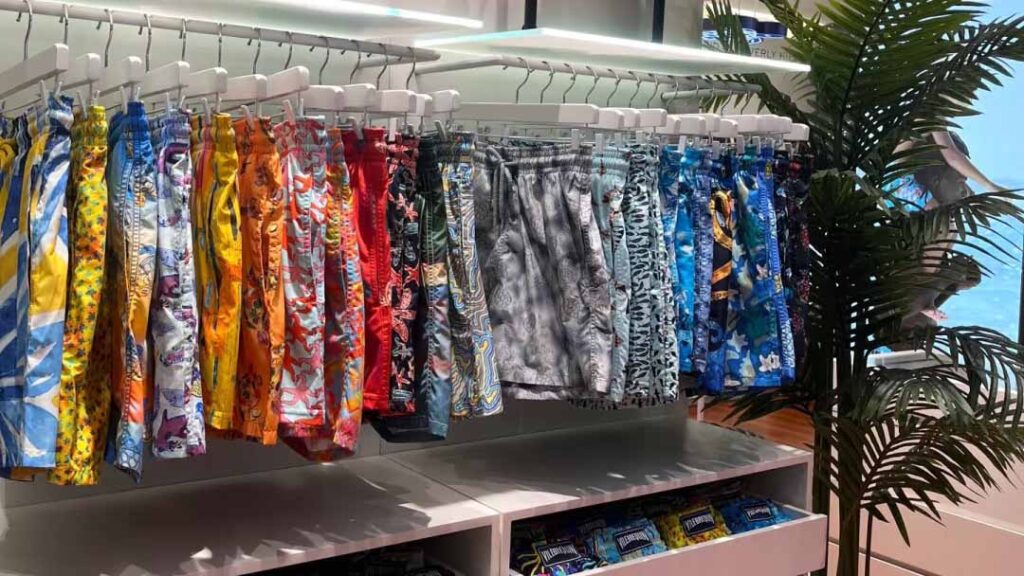
Ever wondered how your favorite swim shorts get those bold patterns or clean logos? I used to think it was just magic—or some fancy machines. Turns out, it’s a mix of technique, fabric, and a little bit of science.
Printing on swim shorts involves several methods like sublimation, screen printing, and heat transfer. Each method delivers different results in terms of color vibrancy, durability, and fabric feel. For brands aiming for high performance and style, choosing the right method depends on the fabric type, design complexity, and budget. This guide breaks it all down in a simple, hands-on way.
Let’s dive into the pool of printing options and see what makes each one special.
Sublimation Printing (Heat Transfer Dye-Sublimation)
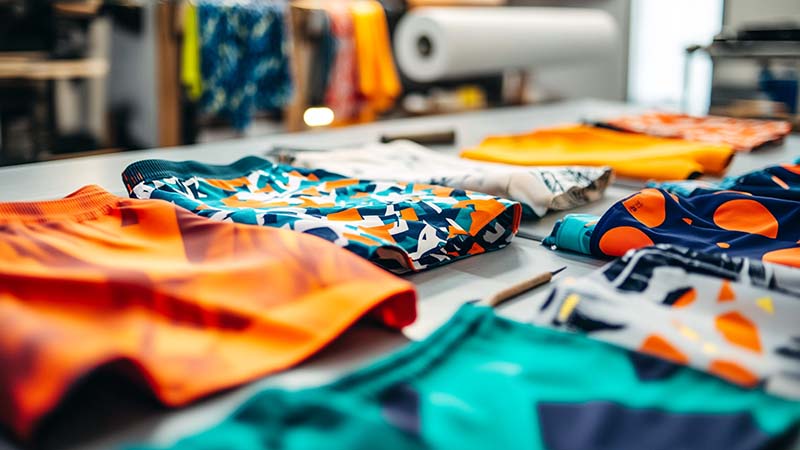
When I first discovered sublimation printing, it felt like unlocking a secret level in the world of custom swimwear. Suddenly, prints were part of the fabric—not just sitting on top.
Sublimation printing, also known as heat transfer dye-sublimation, is a method where heat turns dye into gas, which then bonds with polyester fibers. This results in vibrant, long-lasting designs that won’t crack, peel, or fade—perfect for activewear and swim shorts. It’s ideal for brands that want all-over prints with a soft, seamless finish.
Let me break down how it actually works, and why it’s become my go-to method.
How does dye-sublimation work on swim shorts?
The first time I saw it, I couldn’t believe how clean the result looked. No raised ink, no stiff feel—just pure color.
Dye-sublimation works by printing your design onto transfer paper using sublimation ink. When heat and pressure are applied (usually around 200°C), the ink turns into gas and fuses with the polyester fibers. This means the color becomes part of the fabric itself. Once it cools, you’re left with a smooth, vibrant, and ultra-durable print.
Why Sublimation Only Works on Polyester
You can’t really cheat the system with sublimation—it needs polyester. Here’s why:
| Fabric Type | Sublimation Compatibility | Notes |
|---|---|---|
| Polyester | ✅ Excellent | Color fuses into fibers, long-lasting |
| Nylon | ❌ Poor | Dye doesn’t bond well, often fades |
| Cotton | ❌ Doesn’t work | No bonding occurs, design washes off |
| Poly Blends | ⚠️ Partial | Less vibrant, may fade over time |
Sublimation is a molecular-level magic trick—it needs the right molecules to play with.
What designs work best with sublimation?
I once printed a full Hawaiian sunset scene on a pair of white board shorts. Looked like wearable art.
Sublimation is perfect for full-color, intricate designs—especially those with gradients, photo-quality images, and all-over patterns. Since the dye becomes part of the fabric, there’s no limit to the color range, and no extra weight is added. Logos, tropical prints, branding—everything looks sharp and feels weightless.
Things to Consider
- Works best on white or light-colored fabrics
- Not suitable for dark fabrics (since the ink is transparent)
- Doesn’t create “raised” or “textured” effects—what you see is what you get
How durable is dye-sublimation printing?
I’ve personally worn sublimated swim shorts that still look fresh after two summers of ocean swims, sunscreen, and washing machines.
Sublimation prints are incredibly durable. The colors won’t crack, peel, or fade—even after multiple washes, saltwater dips, or sun exposure. Since the ink is infused into the fabric, there’s no layer to break down over time.
Here’s a quick breakdown:
| Test | Result |
|---|---|
| Wash Resistance | ✅ High |
| UV Resistance | ✅ Minimal fading |
| Flexibility | ✅ Doesn’t crack or stretch out |
| Touch/Feel | ✅ Soft, like the original fabric |
What’s the production process like?
Here’s what it looked like the first time I visited a sublimation shop—it was loud, fast-paced, and surprisingly… artistic.
The process of dye-sublimation includes:
- Design Creation – You (or your designer) prepare a high-res image.
- Transfer Printing – The design is printed onto special sublimation paper using sublimation inks.
- Heat Transfer – The paper is placed on polyester fabric and pressed with heat (200°C) and pressure.
- Cut and Sew – The sublimated fabric is cut and sewn into finished swim shorts.
This “print-then-cut” method allows for full customization—everything from waistband to hem can be covered in your brand’s vibe.
Conclusion
Sublimation isn’t just a printing method—it’s a design freedom tool. For custom swim shorts, it gives me the boldness, durability, and soft feel that I need for my brand to stand out.
👨🏭 Industry Insight (from 15 years in the field):
Sublimation is our go-to for mid to high-end beachwear brands. It allows full-panel printing before stitching, ensuring design continuity across seams. If you’re working with a quick-dry polyester, sublimation is almost unbeatable for visual impact and wear resistance.
Screen Printing
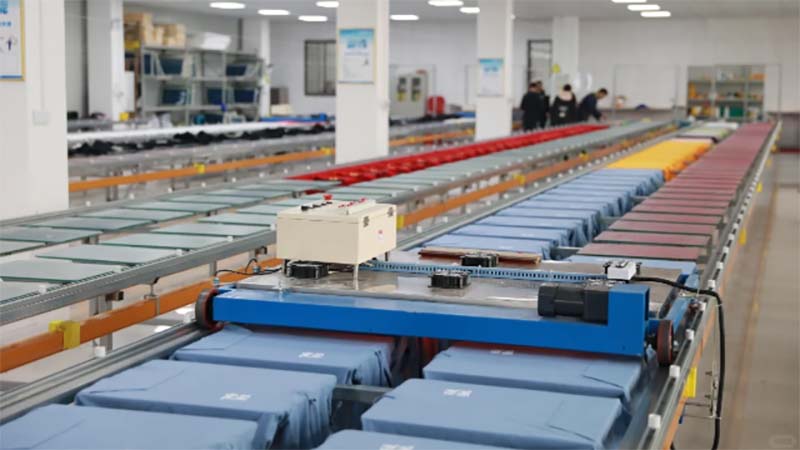
Screen printing was the first method I ever used when I started experimenting with custom shorts. It’s simple, reliable, and still one of the most popular ways to get bold logos or artwork onto swimwear.
Screen printing involves pushing ink through a mesh screen onto fabric, layer by layer. It’s perfect for bold, graphic designs and is cost-effective for large runs. While not as flexible as sublimation, it can be a solid option—if you know how to work with it, especially on fabrics like nylon or polyester.
Let’s break it down so you can decide if it fits your brand.
How does screen printing work on swim shorts?
The first time I tried it, I didn’t expect how much setup was involved. But once it got going? Print after print—super satisfying.
Screen printing uses a stencil (or screen) to apply ink directly onto the fabric. Each color in the design requires its own screen, and the ink is cured with heat to ensure it bonds to the fabric. For swim shorts, this method works best on flat panels before sewing and on non-stretchy or lightly stretchy fabrics.
Why It’s Good (and Where It Struggles)
Screen printing is great for strong, solid graphics—like logos or bold text. But it struggles with high-detail, photo-style prints or fabrics that stretch too much.
| Feature | Screen Printing |
|---|---|
| Best Fabric | Nylon, Polyester |
| Color Vibrancy | ✅ Strong on dark colors |
| Wash Durability | ⚠️ Medium (can crack over time) |
| Feel | Slightly raised, can be thick |
| Stretch Tolerance | ⚠️ Low – may crack |
What designs work well with screen printing?
I remember a time I printed a surf brand’s logo on 300 pairs of red swim trunks. Clean, bold, and consistent—looked great lined up in the warehouse.
Screen printing is best for simple, bold designs with fewer colors. Think logos, slogans, or basic shapes. Each color adds time and cost, so it’s ideal when you’re working with 1-3 colors.
Not Ideal For:
- Photo-realistic images
- Full-bleed prints
- Highly detailed gradients or color transitions
What ink works best for swim shorts?
The wrong ink can ruin your day. (Ask me how I know—one batch literally washed off in the first rinse.)
For swimwear, you’ll need water-resistant inks like plastisol or nylon ink. Plastisol is commonly used—it’s durable, sits on top of the fabric, and holds up well to washing. Nylon ink has better adhesion for slick or coated surfaces.
| Ink Type | Use Case | Pros | Cons |
|---|---|---|---|
| Plastisol | Most fabrics (especially cotton) | Durable, vibrant colors | Can feel thick, not eco-friendly |
| Nylon Ink | Nylon or water-resistant fabrics | Great adhesion, flexible | Requires longer curing time |
| Water-Based | Eco-friendly printing | Softer feel | Poor durability on swimwear |
Screen printing vs. sublimation—what’s the trade-off?
Let’s be real: screen printing and sublimation aren’t fighting each other—they’re just playing different games.
Screen printing excels in bold simplicity, while sublimation rules in detail and durability. If you want a big logo on the left leg and don’t need it to survive five years of beach days, screen printing could be all you need. But for detailed patterns that flow edge to edge, sublimation takes the crown.
| Feature | Screen Printing | Sublimation |
|---|---|---|
| Cost (small runs) | Higher setup cost | Lower for small runs |
| Fabric Feel | Thicker print feel | Soft, no change in texture |
| Color Range | Limited to spot colors | Full spectrum |
| Best For | Logos, text | All-over graphics |
Conclusion
Screen printing is a solid, old-school way to make your swim shorts pop—especially if you’re going for bold branding or simple graphics. Just pick the right fabric, the right ink, and keep the design clean.
👨🏭 Pro Tip:
Screen printing is great for retro or surf-style branding on boardshorts. Use silicone or water-based inks for better flexibility and less rubbery feel.
Digital Direct-to-Garment (DTG) Printing
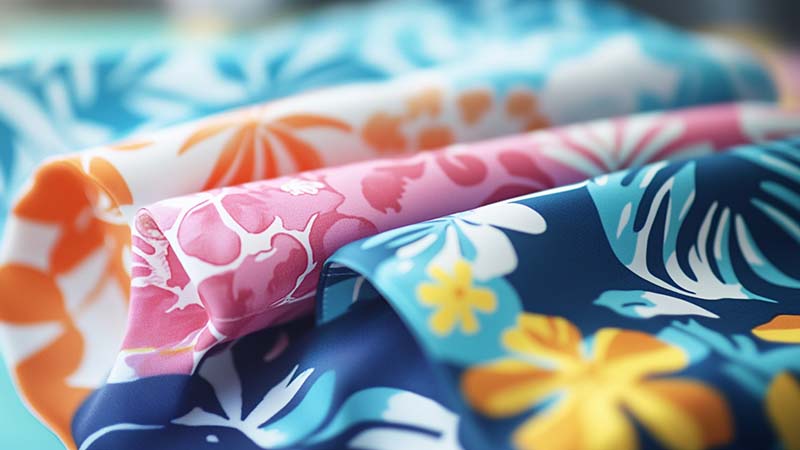
I used to think DTG was just for t-shirts. But one day, I saw someone test it on board shorts—and yeah, it worked, but with a few big “ifs.”
Digital Direct-to-Garment (DTG) printing is a method that prints designs directly onto fabric using inkjet technology. It’s great for cotton-based garments and can produce highly detailed, colorful prints without a complicated setup. But when it comes to swim shorts? It gets a bit tricky—especially with synthetic fabrics.
Let’s get into what works, what doesn’t, and when DTG might be worth considering.
Can DTG printing be used on swim shorts?
Short answer? Rarely. And if it does work, it’s usually not ideal long-term.
DTG printing is mainly designed for cotton or cotton-blend garments, not synthetic fabrics like polyester or nylon, which are commonly used for swim shorts. The ink doesn’t bond well to slick or water-resistant surfaces, leading to fading or peeling after just a few washes. So while it might look great at first, durability is a major issue.
Why DTG and Swim Shorts Usually Don’t Mix
Here’s what I’ve learned from trying it out (yes, I’ve been there):
| Fabric Type | DTG Compatibility | Notes |
|---|---|---|
| Cotton | ✅ Excellent | High quality, vibrant and durable |
| Cotton-Poly Blend | ⚠️ Partial | Less vibrancy, may fade faster |
| Polyester | ❌ Not ideal | Ink sits on top, prone to washing off |
| Nylon | ❌ Nope | Ink can’t bond, poor wash durability |
Unless you’re working with some kind of special pre-treated hybrid fabric, DTG just doesn’t love swimwear.
What designs are best suited for DTG?
If you’re printing on cotton tees for your beachwear line, DTG can be a lifesaver.
DTG is best for high-resolution, full-color images with lots of detail and color gradients. Think photographic prints, artwork, or multi-shade logos. Since the printer works like an inkjet, there are almost no color limitations.
For Swim Shorts?
- Avoid it unless you have a cotton-blend swim trunk (rare)
- Use for mockups or concept testing only
- Not ideal for production runs intended for water use
How does DTG printing compare to other methods?
This was one of my biggest learning curves when I started customizing products: not all “printing” is created equal.
DTG printing offers incredible detail, but falls short in durability on swimwear fabrics. Compared to sublimation or screen printing, it’s more limited by fabric type and prone to wear and tear under wet, salty, or stretchy conditions.
| Method | Durability (Swimwear) | Design Detail | Best Use Case |
|---|---|---|---|
| DTG | ❌ Low | ✅ High | Cotton apparel, prototypes |
| Sublimation | ✅ Excellent | ✅ High | Polyester swimwear |
| Screen Print | ⚠️ Medium | ⚠️ Moderate | Logos on nylon or poly |
| Heat Transfer | ⚠️ Medium | ✅ Moderate | Small runs, personalization |
When is DTG worth considering?
There was a time I used DTG to make a set of branded cotton boardwalk tees that matched our swim shorts. They looked fantastic and helped bring the whole collection together.
DTG is perfect for complementary items like t-shirts, tank tops, or cotton-based beachwear. It’s also great for small batch testing or when you want photo-realistic detail without investing in screens or transfer papers.
Just keep it out of the water.
Conclusion
DTG printing has its place—but it’s not really in the surf. For swim shorts, stick with sublimation or screen printing. Use DTG where it shines: detailed prints on cotton, not chlorine-tested fabrics.
👨🏭 Note from Experience:
While DTG is trendy for tees, it’s less suited to swimwear unless you’re doing fashion shorts for casual wear, not performance swim.
Heat Transfer Vinyl (HTV)
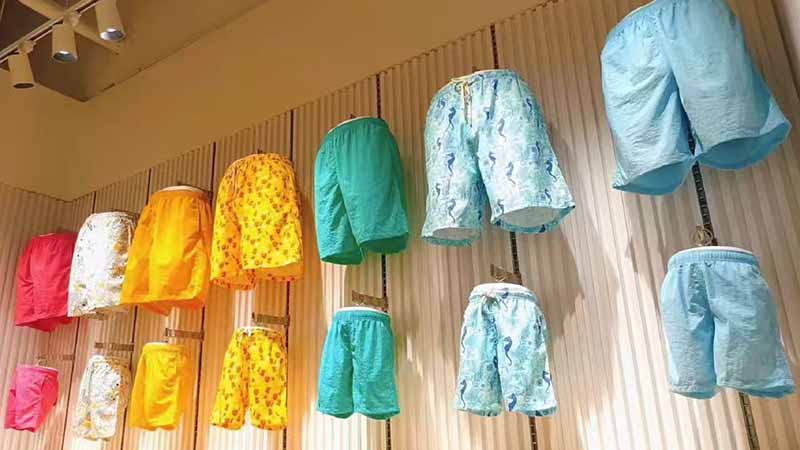
I remember the first time I used heat transfer vinyl (HTV)—I made custom names on a volleyball team’s board shorts. They looked awesome for the weekend, but by the next month? Let’s just say… they didn’t age well.
Heat Transfer Vinyl (HTV) is a method where vinyl designs are cut, placed on fabric, and fused using heat and pressure. It’s great for small runs, personalizing names or numbers, and making simple graphics pop. But for swim shorts, you’ve got to know the trade-offs—especially when it comes to durability.
Let’s peel back the layers on HTV (pun intended) and see where it fits in your brand toolkit.
Can HTV be used on swim shorts?
Yep. But like with most things in life—just because you can, doesn’t mean you always should.
HTV can be applied to swim shorts, especially those made from nylon or polyester. It adheres using a heat press, and as long as the fabric can withstand the temperature (typically 280–320°F), it’ll stick. But—and this is a big one—it’s not as durable as other methods when exposed to chlorine, salt, or intense stretching.
What You Need to Watch Out For
From personal experience, HTV starts to show wear if:
- The shorts are frequently machine-dried
- They’re used in pools or the ocean regularly
- The vinyl design is large or spans across seams
| Factor | HTV Performance |
|---|---|
| Durability (wet use) | ⚠️ Medium–Low |
| Color Vibrancy | ✅ Strong (solid colors) |
| Flexibility | ⚠️ Limited |
| Design Feel | Textured, slightly raised |
| Application Ease | ✅ Easy for small runs |
What kind of designs work best with HTV?
I’ve used HTV for logos, initials, numbers—and once, a customer wanted pineapples on the back pocket. That one actually turned out pretty great.
HTV is best for simple, bold graphics—like brand logos, initials, or one-color designs. It’s especially handy when you’re doing customization, like individual names or numbers on team shorts. You can even layer different vinyls for multi-color designs, though it can get thick fast.
Avoid HTV for:
- Full-color photo prints
- All-over designs
- Ultra-stretchy swim fabrics
What types of vinyl can be used?
Not all vinyl is created equal. If you’re printing on swimwear, go for the flexible, stretchable kind—it’ll hold up better.
| Type of Vinyl | Best Use Case | Notes |
|---|---|---|
| Standard HTV | Logos, basic graphics | May crack on stretch fabric |
| Stretch HTV | Swimwear, activewear | More flexible and durable |
| Glitter/Metallic HTV | Fashion shorts, accents | Looks great but less durable |
| Reflective HTV | Safety or night-use branding | Cool look, but stiff feel |
Pro tip: Always test one pair first. Some coatings on nylon or poly repel even the best vinyls.
How does HTV compare to other printing methods?
HTV isn’t a long-term player like sublimation—but it’s a great benchwarmer for quick runs or custom names.
Compared to other methods, HTV stands out for ease and flexibility on short runs—but lacks in long-term durability.
| Method | Setup Cost | Durability | Best For |
|---|---|---|---|
| HTV | Low | ⚠️ Medium | Custom names, short runs |
| Sublimation | Medium | ✅ High | All-over prints, polyester |
| Screen Printing | Medium | ⚠️ Medium | Logos, bulk production |
| DTG | Low | ❌ Low | Cotton shirts, not swimwear |
When should I use HTV?
HTV is your go-to for short, fast, personalized projects. I’ve used it for:
- Limited edition drops (25 pairs or less)
- Staff uniforms
- Personalized promo items
- Prototype samples to test a logo or placement
Just be ready to explain to customers that it’s not a “forever” print—especially if they plan to hit the waves hard.
Conclusion
HTV is a fast, easy way to add personal touches to swim shorts—but it’s not built for the long haul. Use it wisely, test your fabrics, and keep expectations clear.
👨🏭 Practical Insight:
HTV works great for sample runs or local brands doing in-house production. I recommend heat-resistant vinyl + pre-treated fabrics to ensure adhesion during sun & water exposure.
All-over Rotary or Flatbed Screen Printing (For Bulk)
When I first walked through a rotary screen printing factory, I was blown away—massive machines, bold colors, and rolls of fabric being transformed into artwork at lightning speed. This is where high-volume magic happens.
All-over rotary and flatbed screen printing are industrial techniques used to print large, continuous patterns onto rolls of fabric before they’re cut and sewn. These methods are ideal for bulk swim shorts production, especially when you’re aiming for consistent, full-coverage designs at scale. Think tropical prints, geometric patterns, or your brand’s signature motif.
Here’s everything I’ve learned from working with this method—pros, cons, and when it makes sense for your brand.
What is all-over rotary and flatbed screen printing?
Imagine printing on fabric like a newspaper press. Instead of printing one item at a time, you’re printing yards of fabric in one go.
Rotary screen printing uses cylindrical screens to print continuous patterns onto fabric, while flatbed screen printing uses flat screens for placement prints. Both methods are designed for high-volume runs and can handle multiple colors, though rotary is faster and better for seamless, repeating patterns.
Rotary vs. Flatbed at a Glance
| Feature | Rotary Screen Printing | Flatbed Screen Printing |
|---|---|---|
| Best For | Continuous/repeating prints | Placement prints (logos/panels) |
| Speed | ✅ Very high | ⚠️ Medium |
| Setup Cost | ⚠️ High | ⚠️ High |
| Volume Efficiency | ✅ Excellent | ✅ Good for medium-high runs |
| Fabric Compatibility | Polyester, nylon | Polyester, nylon |
| Detail Level | ⚠️ Moderate (limited by mesh) | ✅ Higher precision possible |
Why is it ideal for bulk swim short production?
One word: efficiency. When I worked with a client who needed 10,000 units of printed shorts, rotary was the only way we could meet their timeline and keep the costs down.
Rotary and flatbed screen printing are perfect for producing thousands of meters of fabric with consistent patterns. Since the printing happens before the sewing stage, you get edge-to-edge coverage, zero alignment issues, and smooth design flow across panels.
Here’s what makes it shine in bulk:
- Cost per unit drops significantly after setup
- Excellent for seasonal or signature all-over designs
- High ink penetration for long-lasting color
- Works well on polyester blends used in swim shorts
What kind of designs work best?
Ever seen those pineapple-print trunks or seamless palm leaf patterns? That’s rotary at work.
All-over patterns with clear repetition are perfect for rotary. Flatbed is better for exact placement prints—like a logo on the left leg or waistband accent.
| Design Type | Recommended Method |
|---|---|
| Repeating pattern (tropical) | ✅ Rotary |
| One logo on front panel | ✅ Flatbed |
| Photorealistic image | ❌ Use Sublimation |
| Custom names or details | ❌ Use HTV or Heat Transfer |
What’s the production workflow like?
It’s not a fast start—but once you’re set up, it flies.
Typical steps include:
- Engraving Screens – One screen per color (can be 8+).
- Mixing Inks – Custom colors are mixed to match design.
- Test Runs – Swatches are printed to check alignment and color.
- Mass Printing – Fabric rolls are printed at high speed.
- Fixing/Drying – Heat or chemical treatment to lock in color.
- Cut and Sew – Printed fabric is turned into finished shorts.
Just keep in mind: the minimums are high (usually 1,000 meters of fabric), and screens take time to prep.
How does it compare to digital and sublimation?
Rotary and flatbed aren’t as trendy as digital printing, but in high volumes, they’re the real MVP.
| Method | Setup Cost | Min Order | Durability | Color Range | Best For |
|---|---|---|---|---|---|
| Rotary/Flatbed | High | ✅ High | ✅ High | ⚠️ Limited | All-over prints in bulk |
| Sublimation | Medium | ⚠️ Medium | ✅ High | ✅ Unlimited | Detailed graphics, polyester |
| Digital (DTG) | Low | ❌ Low | ❌ Low | ✅ Unlimited | Cotton t-shirts, not swimwear |
When should I choose this method?
If your brand is scaling up, rotary printing can seriously lower your cost per unit.
Use rotary or flatbed when:
- You’re producing 1,000+ pairs of the same style
- You need seamless, repeating prints
- Your budget allows for upfront screen and setup costs
- Your fabric is polyester or a suitable synthetic blend
I’ve seen brands use rotary printing to own a signature look that screams their identity. It’s not the flashiest method—but it’s a reliable workhorse for serious business.
Conclusion
All-over rotary and flatbed screen printing are perfect for high-volume swim shorts production with repeating designs. If you’re scaling up, it could be your brand’s next smart move.
👨🏭 Behind-the-Scenes:
We use rotary screen printing for many resort-wear clients. It’s cost-effective at 10,000+ pieces and ensures print alignment before cutting/stitching.
Choosing the Right Print Method for Your Brand
| Method | Best Fabric | MOQ | Durability | Cost/Unit | Design Freedom |
|---|---|---|---|---|---|
| Sublimation | Polyester | Low | ★★★★★ | $$ | ★★★★★ |
| Screen Printing | Cotton/Blends | Mid–High | ★★★★☆ | $ | ★★☆☆☆ |
| DTG | Cotton | Low | ★★☆☆☆ | $$$ | ★★★★☆ |
| Heat Transfer | Synthetic/Blend | Low | ★★★☆☆ | $$ | ★★★☆☆ |
| Rotary/Flatbed | Any (bulk rolls) | High | ★★★★★ | $ | ★★★☆☆ |
Final Thoughts: Print Quality Is Brand Quality
Printing isn’t just decoration—on swim shorts, it’s your brand’s story, front and center. Whether you want bold, sporty designs or elegant, resort-style patterns, choosing the right method determines how your product will be perceived and how long it’ll last under sun, salt, and surf.
👨🏭 Expert Takeaway:
In my 15 years working with international swimwear brands, the best results come from understanding your fabric before choosing your print method. What looks great in the showroom has to survive hundreds of beach days. Always test your print + fabric + wash cycle before scaling production.
.png)


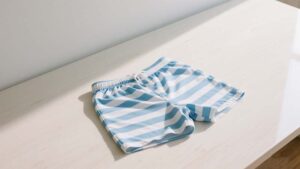
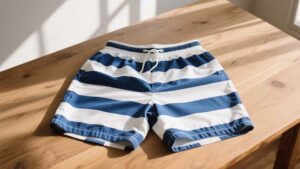
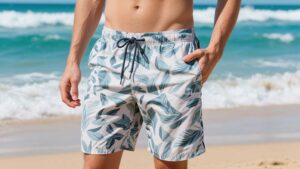


-1024x337.png)